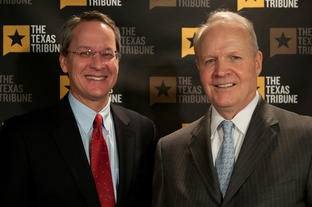
These gaps further expand during the postsecondary years: white students’ rates of earning a college credential are two to two and a half times higher than those of Hispanics and blacks. Given the state’s growing Hispanic population, this means that it will be impossible for Texas to contribute its share in reaching national attainment goals without improving Hispanic college-going and graduation rates. The gap between Asian and white students is almost 11 percentage points for entering college. The gap increases to nearly 14 percentage points for earning a college credential–Tracking the Success of 8th Graders into and through Report.
With young Latinos in Texas predicted to pick the tab for services provided to an aging “Anglo” population, the fact that Latinos are not graduating from College at the same rate as “Anglos” should be equally troubling for Republicans and Democrats.
You can read the interview Larry Faulkner, director of Houston Endowmen, and the Texas Tribune. Or you can read the full report in PDF format here.
 After stepping down as president of the University of Texas in 2006, a post he had held since 1998, Larry Faulkner took the reins of the Houston Endowment.
After stepping down as president of the University of Texas in 2006, a post he had held since 1998, Larry Faulkner took the reins of the Houston Endowment.
He retired from his post as president at the philanthropic organization last month, but he’s making the rounds — including a stop at the offices of The Texas Tribune last week — to spread the word about the results of a Houston Endowment project he hopes will change the way people in Texas think and talk about education.
Rather than analyzing the state’s higher education success using traditional metrics, the endowment tracked all the eighth graders in Texas public schools to see how many earned some type of higher education credential in the decade following their eighth-grade graduation. The result: Less than 22 percent did.
George Grainger, the endowment’s director of research and planning, said that it was not yet possible to put those results in a national context. The only other state with a database capable of allowing for apples-to-apples comparisons is Florida’s, but others should be coming online soon.
The Houston Endowment has pledged to continue tracking the measurement. In the meantime, Faulkner and Grainger talked with the Tribune about the state’s education problems and why the number of students who earn higher education credentials might start to fall without major changes.
Faulkner also gave his take on the debate over higher education reform.
The following is an edited and abbreviated transcript:
TT: What’s the take-away from your results? It sounds like it’s not great news.
Faulkner: I think part of the news is the fact of where the state lies, but that’s actually not the first message. The first message is that Houston Endowment has been looking for some time for a good measure of how we’re doing educationally on a combined basis, higher ed and K-12 wrapped up in one package. How are we doing and how can that be measured in an incorruptible way?
Part of this is rolling out a measure that is up to this task. There are thousands of educational statistics. Not many, maybe none, really capture the roll-up of both K-12 and higher ed.
This is definitely a “lies, damn lies and statistics” sort of domain here. Education statistics, I think they get corrupted. High school graduation rates notoriously get corrupted. You can’t believe those data at all because of games that get played in school districts and others.
So we’re looking for something that can’t be corrupted. What we’re doing is counting eighth graders. It’s easy to count eighth graders
Grainger: Every one of them. We can find every one of them in public school. In all of Texas.
Faulkner: Right, so we count eighth graders and we allow time to elapse — 10 years after the eighth grade. Then, we find out how many of them have achieved any kind of credential. We want to know that much percentage. We know the kids, follow the same kids and find out what the result was.
That measure is about 21.9 percent for Texas, which is about half of what people guess if you play the parlor game.
TT: What did you guys think it would be?
Grainger: Well, the Texas Higher Education Coordinating Board had done a similar study three times for earlier cohorts. Part of our idea was to see if we could hire a third-party research outfit to replicate the coordinating board study. They started in seventh grade. We start in eighth grade because that will match up with how other states are going to measure student progress, so we could match Texas with other states.
Part of it was to see if we can replicate this. We can, with great confidence. We were aware of the coordinating board results, so we weren’t surprised by this. But there are a lot of people that are.
He was very surprised.
Faulkner: When he first sprung this on me, I was very surprised. And I know a lot about education.
TT: Do we know what’s happening to the other 80 percent?
Grainger: You can look at national employment data, national earnings data, and come to a reasonable conclusion that not a lot of good things are happening to those 80 percent.
For baccalaureate degree holders in the United States, it’s essentially full employment. It’s about a 4 percent unemployment rate, and that’s getting close to full. With no high school degree or high school dropout, it’s four or five times that. And with weekly earnings, there are huge disparities depending on your level of achievement and credentialing. My conclusion is that the 80 percent, a lot of them don’t have good potential for reasonable life outcomes if you think about what it takes to achieve a modestly middle-class lifestyle.
Faulkner: One thing that’s important to know is that more people than the 21.9 actually do get a viable credential. Some of them get it in the military, some get it through apprenticeship programs or other programs. So people get work credentials on a larger scale than this. We don’t want to represent that we’re counting absolutely everything that can produce a post-high school validation.
But we are measuring something that covers the bulk of the population and is a good index for how K-12 and higher ed are doing.
There are several loss stages in the system. It’s probably notable that about a third of kids in Texas don’t graduate from high school. That’s one big loss zone.
Then, another big body of people actually enroll in higher education but don’t ever do anything with it. There actually are more college dropouts in Texas than there are high school drop outs.
Then, you have a third group that completes high school and never attempts post-secondary education. You’ve got those three groups that make up the 80 percent.
What we’re saying here with this index is that we know what the performance is. What we want to do is follow it over a number of years. So the index will be available. The question is will we get better.
Our contention is that we can work on getting better at a lot of points. There’s not one silver bullet to fix this.
TT: Are you telling people how to bring those numbers up?
Grainger: We’re simply saying that we believe this number is accurate; we believe it’s a valid indicator of the success of the education enterprise in Texas. We’ve gone out of our way to say that we don’t know what the number should be or how to get there.
It can, in some ways, serve as an overlay of this sort of plethora of education statistics and measures. It’s simple to understand, simple to calculate and very reliable.
Faulkner: One thing we haven’t mentioned and shouldn’t allow this to go very much further before we do is that — we call this thing “the number” — and “the number” for Texas as a whole is 21.9 percent. But for the Hispanic and African-American population, it’s 11 to 12 percent. So the number that are not getting any kind of certification is 90 percent for that group. And Hispanic population growth in Texas is such a big story that what that says for the future is also a big story.
Grainger: The mathematics really work against you on trying to sustain 21 or 22 percent just because of this bulge of young Hispanic kids who are starting to make their way through the system, and their yield is half of the average. So, it’s going to start pulling down the average unless something has happened. And hopefully something will.
TT: Dr. Faulkner, as someone who has been in education for a long time, why is a new measurement needed?
Faulkner: One thing I think is a big issue in the education world is the relative hostility and uncooperativeness across the boundary between K-12 and higher ed. I think both sides of this will tell you it’s their fault — the other side’s fault. What I like about this measure is that neither side can do that. This measure talks about what we’re doing in a way that frankly captures both sides.
Higher ed can say to K-12 that they’re not getting these kids ready well enough and you’re not keeping enough of them in school. All true. But they can’t deny that what they do with students after they get there, and the fact that more of them drop out of higher ed than K-12, higher ed has to take responsibility for that.
The most important thing is that neither side gets to brush off this statistic and say, “It’s not my problem.”
TT: You also know a thing or two about UT, obviously. What did you think as you observed the dust-up over higher ed reform last year? And where do you think things stand with that debate?
Faulkner: I think the debate arises and public concern arises over higher education first because of cost issues and what’s happened there. I think there are real reasons for concern in that sector.
So I’m not surprised that there’s a major public discussion. The question is whether the right kinds of strategies are being pushed to improve that situation. I doubt that. I think we have a system in this country that has been spectacularly successful. That’s not to say that it doesn’t have things to improve, but it’s undeniable that it’s been spectacularly successful. The entire world is mimicking it.
The model is effective. The question is how can you go about addressing costs to students and parents in an effective way that can preserve the quality of the system.
I think a tremendous amount is at stake here. National competitiveness is at stake here. And I think we could really screw up a major national asset. So I think care is needed.
On the non-higher ed side, by which I mean the public, I think it’s perfectly reasonable for the public to express its concerns and to show a lot of interest in innovation and ways to improve approaching these issues. And they should expect it to be taken seriously.
And on the inside, the academic world has got to take it really seriously. And I think they are, but I think it’s been slow sinking in.
This interview was posted on the Texas Tribune on 3/20/2012



